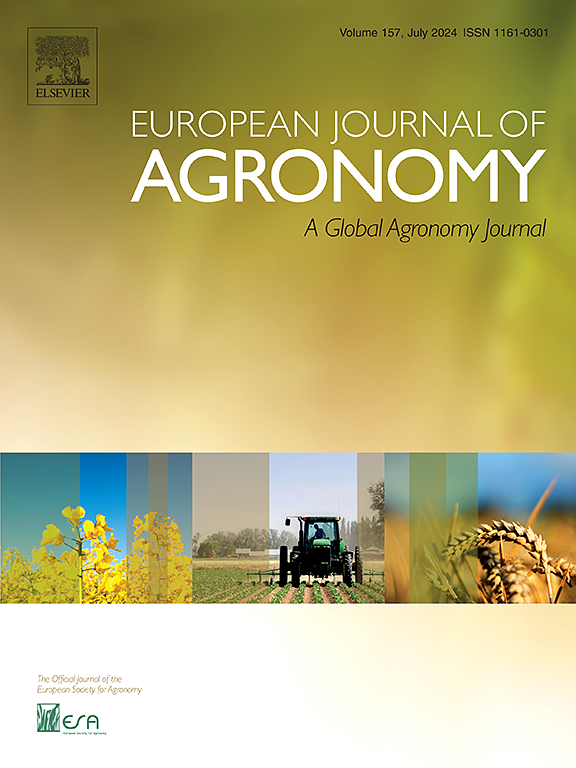Ex-ante analyses using machine learning to understand the interactive influences of environmental and agro-management variables for target-oriented management practice selection
IF 4.5
1区 农林科学
Q1 AGRONOMY
引用次数: 0
Abstract
Conservation management in dryland agriculture preserves water, improves soil health and yields. To comprehend the complex interactions of conservation management and environmental factors in a rainfed forage system of the US Great Plains, distinguish the superior influence of conservation over conventional management, and have a different perspective from simulation modeling, machine learning (ML) and artificial intelligence models were adapted in 2022. The variables in this study included ten years of daily recorded weather data and yield values simulated by the DSSAT model suite, considering four years of actual data on aboveground and belowground biomass, depth-wise carbon, water content, various physicochemical soil parameters, and management practices (Sarkar and Northup 2023). Two optimized ML models, Random Forest and AdaBoost, were found to perform better, when the algorithms of six ML models- namely Decision Tree, Random Forest, Bagging, Gradient Boosting, AdaBoost and XGBoost were tuned with different hyperparameters, validated and trained before predicting the biomass yields. Feature Importance plotting by these two models revealed the five most influencing similar variables, which were in different orders: average maximum temperature during daylight hours, total soil water, seasonal average minimum temperature, cumulative potential evapotranspiration and CO2. Hence, SHapley Additive exPlanation (SHAP) algorithm was adopted to dive into the database and clarify the interaction effects of management practices especially tillage and soil cover with different environmental variables. Interestingly, the SHAP model indicated soil cover as the 5th most important variable, followed by maximum temperature during daylight hours, cumulative potential evapotranspiration, seasonal minimum temperature and CO2. The interaction plotting of SHAP analysis also manifested that intensity of tillage and use of no soil cover could be detrimental. Considering the rising atmospheric CO2 levels and temperatures, along with depleting soil water, no-till practices with a springtime cover of grass peas or field peas and the addition of 100 % residue can be acclaimed for high water-use efficiency and increased aboveground biomass of rainfed sorghum sudangrass in drylands. We recommend using impeccable dataset, particularly from diverse agro-environmental systems with various tillage practices and soil covers, before regional adoption. Additionally, exploring the impacts on diverse soil types is advisable before selecting a sustainable management strategy for precision agriculture.
利用机器学习进行事前分析,以了解环境和农业管理变量的交互影响,从而选择以目标为导向的管理方法
旱地农业中的保护性管理可以保护水源、改善土壤健康和提高产量。为了理解美国大平原雨养牧草系统中保护性管理与环境因素之间复杂的相互作用,区分保护性管理相对于传统管理的优势影响,并从模拟建模的不同视角出发,2022 年采用了机器学习(ML)和人工智能模型。这项研究的变量包括十年每日记录的天气数据和 DSSAT 模型套件模拟的产量值,并考虑了四年关于地上和地下生物量、深度碳、含水量、各种土壤理化参数和管理方法的实际数据(Sarkar 和 Northup,2023 年)。在预测生物量产量之前,使用不同的超参数对六个 ML 模型(即决策树、随机森林、Bagging、梯度提升、AdaBoost 和 XGBoost)的算法进行调整、验证和训练,发现随机森林和 AdaBoost 这两个优化的 ML 模型表现更好。这两个模型的特征重要性图显示了五个影响最大的相似变量,它们依次是:白天平均最高气温、土壤总水量、季节平均最低气温、累积潜在蒸散量和二氧化碳。因此,采用了 SHapley Additive exPlanation(SHAP)算法来深入研究数据库,并阐明管理方法,尤其是耕作和土壤覆盖与不同环境变量之间的交互作用。有趣的是,SHAP 模型表明,土壤覆盖是第 5 个最重要的变量,其次是白天最高温度、累积潜在蒸散量、季节最低温度和二氧化碳。SHAP 分析的交互图还表明,耕作强度和不使用土壤覆盖物可能是有害的。考虑到大气中二氧化碳含量和气温不断升高,以及土壤水分日益枯竭,在春季覆盖禾本科豌豆或大田豌豆并添加 100% 的残留物的免耕方法可提高旱地雨养高粱的水分利用效率,增加其地上生物量。我们建议在区域性采用之前,使用无懈可击的数据集,特别是来自不同耕作方式和土壤覆盖物的多样化农业环境系统的数据集。此外,在为精准农业选择可持续管理策略之前,最好先探讨对不同土壤类型的影响。
本文章由计算机程序翻译,如有差异,请以英文原文为准。
求助全文
约1分钟内获得全文
求助全文
来源期刊

European Journal of Agronomy
农林科学-农艺学
CiteScore
8.30
自引率
7.70%
发文量
187
审稿时长
4.5 months
期刊介绍:
The European Journal of Agronomy, the official journal of the European Society for Agronomy, publishes original research papers reporting experimental and theoretical contributions to field-based agronomy and crop science. The journal will consider research at the field level for agricultural, horticultural and tree crops, that uses comprehensive and explanatory approaches. The EJA covers the following topics:
crop physiology
crop production and management including irrigation, fertilization and soil management
agroclimatology and modelling
plant-soil relationships
crop quality and post-harvest physiology
farming and cropping systems
agroecosystems and the environment
crop-weed interactions and management
organic farming
horticultural crops
papers from the European Society for Agronomy bi-annual meetings
In determining the suitability of submitted articles for publication, particular scrutiny is placed on the degree of novelty and significance of the research and the extent to which it adds to existing knowledge in agronomy.
 求助内容:
求助内容: 应助结果提醒方式:
应助结果提醒方式:


